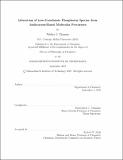| dc.contributor.advisor | Christopher C. Cummins. | en_US |
| dc.contributor.author | Transue, Wesley J | en_US |
| dc.contributor.other | Massachusetts Institute of Technology. Department of Chemistry. | en_US |
| dc.date.accessioned | 2019-03-11T19:04:20Z | |
| dc.date.available | 2019-03-11T19:04:20Z | |
| dc.date.copyright | 2018 | en_US |
| dc.date.issued | 2018 | en_US |
| dc.identifier.uri | http://hdl.handle.net/1721.1/120876 | |
| dc.description | Thesis: Ph. D., Massachusetts Institute of Technology, Department of Chemistry, 2018. | en_US |
| dc.description | This electronic version was submitted by the student author. The certified thesis is available in the Institute Archives and Special Collections. | en_US |
| dc.description | Page 467 blank. Cataloged from student-submitted PDF version of thesis. | en_US |
| dc.description | Includes bibliographical references. | en_US |
| dc.description.abstract | The study of heavier p-block analogs to unsaturated organic small molecules is of fundamental importance, allowing insight into the differing bonding and reactivity patterns that control their synthetic utility. A major complication in this pursuit is the instability of these unsaturated compounds containing heavier elements, as they can rarely be isolated without sterically encumbering substituents to provide kinetic protection. Herein, a series of anthracene-based molecular precursors are leveraged for the generation of low-coordinate phosphorus species that have been generally too unstable to isolate and use under ambient conditions. These precursors exhibit a dibenzo-7-phosphanorbornadiene framework that has allowed access to free phosphinidenes, phosphinidene sulfides, and phosphaalkynes. The thermal release of anthracene as a relatively innocuous coproduct allows for studies of these species' reactivities toward new substrates. Where possible, the intermediacy of the unstable phosphorus compound is demonstrated by direct spectroscopic detection, particularly using nuclear magnetic resonance (NMR) and microwave (rotational) spectroscopy. The mechanism and scope of thermal fragmentation of these molecular precursors is described from experimental kinetic studies bolstered by density functional theory (DFT) calculations. Initial forays into further uses of dibenzo-7-phosphanorbornadiene compounds have included the preparation of a new material of composition P2S and the transition metal-catalyzed transfer of tert-butylphosphinidene to styrene to generate phosphiranes. | en_US |
| dc.description.statementofresponsibility | by Wesley J. Transue. | en_US |
| dc.format.extent | 467 pages | en_US |
| dc.language.iso | eng | en_US |
| dc.publisher | Massachusetts Institute of Technology | en_US |
| dc.rights | MIT theses are protected by copyright. They may be viewed, downloaded, or printed from this source but further reproduction or distribution in any format is prohibited without written permission. | en_US |
| dc.rights.uri | http://dspace.mit.edu/handle/1721.1/7582 | en_US |
| dc.subject | Chemistry. | en_US |
| dc.title | Liberation of low-coordinate phosphorus species from anthracene-based molecular precursors | en_US |
| dc.type | Thesis | en_US |
| dc.description.degree | Ph. D. | en_US |
| dc.contributor.department | Massachusetts Institute of Technology. Department of Chemistry | |
| dc.identifier.oclc | 1088898054 | en_US |
